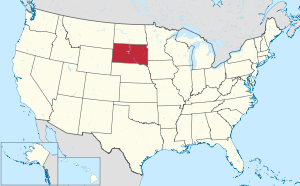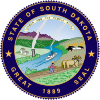
Back Suid-Dakota Afrikaans ደቡብ ዳኮታ Amharic Dakota d'o Sud AN Sūþdacota ANG داكوتا الجنوبية Arabic ܣܐܘܬ ܕܐܟܘܬܐ ARC داكوطا لجنوبية ARY ساوث داكوتا ARZ Dakota del Sur AST South Dakota suyu Aymara
South Dakota
Dakȟóta itókaga (Lakota) | |
|---|---|
| Nickname: The Mount Rushmore State (official) | |
| Motto(s): Under God, the People Rule | |
| Anthem: "Hail, South Dakota!" | |
 Location of South Dakota within the United States | |
| Country | United States |
| Before statehood | Dakota Territory |
| Admitted to the Union | November 2, 1889 (40th) |
| Capital | Pierre |
| Largest city | Sioux Falls |
| Largest county or equivalent | Minnehaha County |
| Largest metro and urban areas | Sioux Falls |
| Government | |
| • Governor | Kristi Noem (R) |
| • Lieutenant governor | Larry Rhoden (R) |
| Legislature | South Dakota Legislature |
| • Upper house | Senate |
| • Lower house | House of Representatives |
| Judiciary | South Dakota Supreme Court |
| U.S. senators | John Thune (R) Mike Rounds (R) |
| U.S. House delegation | Dusty Johnson (R) (list) |
| Area | |
• Total | 77,116[1] sq mi (199,729 km2) |
| • Land | 75,811 sq mi (196,350 km2) |
| • Water | 1,305 sq mi (3,379 km2) 1.7% |
| • Rank | 17th |
| Dimensions | |
| • Length | 380 mi (610 km) |
| • Width | 210 mi (340 km) |
| Elevation | 2,200 ft (670 m) |
| Highest elevation | 7,244 ft (2,208 m) |
| Lowest elevation | 968 ft (295 m) |
| Population (2024) | |
• Total | |
| • Rank | 46th |
| • Density | 11.50/sq mi (4.44/km2) |
| • Rank | 46th |
| • Median household income | $71,800 (2023)[5] |
| • Income rank | 33rd |
| Demonym | South Dakotan |
| Language | |
| • Official language | English, Sioux (official indigenous language)[6] |
| • Spoken language | English, Spanish (2.06%), Dakota[6][7] (1.39%), German (1.37%)[8] |
| Time zones | |
| eastern half | UTC−06:00 (Central) |
| • Summer (DST) | UTC−05:00 (CDT) |
| western half | UTC−07:00 (Mountain) |
| • Summer (DST) | UTC−06:00 (MDT) |
| USPS abbreviation | SD |
| ISO 3166 code | US-SD |
| Traditional abbreviation | S.D., S.Dak. |
| Latitude | 42°29′ N to 45°56′ N |
| Longitude | 96°26′ W to 104°03′ W |
| Website | sd |
South Dakota (/dəˈkoʊtə/ ⓘ;[9] Sioux: Dakȟóta itókaga, pronounced [daˈkˣota iˈtokaga]) is a landlocked state in the North Central region of the United States. It is also part of the Great Plains. South Dakota is named after the Dakota Sioux tribe, which comprises a large portion of the population — with nine reservations currently in the state — and has historically dominated the territory.[10] South Dakota is the 17th-largest by area, but the fifth-least populous, and the fifth-least densely populated of the 50 United States. Pierre is the state capital, and Sioux Falls, with a population of about 213,900,[11] is South Dakota's most populous city.[12] The state is bisected by the Missouri River, dividing South Dakota into two geographically and socially distinct halves, known to residents as "East River" and "West River".[13] South Dakota is bordered by North Dakota to the north, Minnesota to the east, Iowa to the southeast, Nebraska to the south, Wyoming to the west, and Montana to the northwest.
Humans have inhabited the area for several millennia, with the Sioux becoming dominant by the early 19th century. In the late 19th century, European-American settlement intensified after a gold rush in the Black Hills and the construction of railroads from the east. Encroaching miners and settlers triggered a number of Indian wars, ending with the Wounded Knee Massacre in 1890. As the southern part of the former Dakota Territory, South Dakota became a state on November 2, 1889, simultaneously with North Dakota. They are the 39th and 40th states admitted to the union; President Benjamin Harrison shuffled the statehood papers before signing them so that no one could tell which became a state first.[14]
Key events in the 20th century included the Dust Bowl and Great Depression, increased federal spending during the 1940s and 1950s for agriculture and defense, and an industrialization of agriculture that has reduced family farming. Eastern South Dakota is home to most of the state's population, and the area's fertile soil is used to grow a variety of crops. West of the Missouri River, ranching is the predominant agricultural activity, and the economy is more dependent on tourism and defense spending. Most of the Native American reservations are in West River. The Black Hills, a group of low pine-covered mountains sacred to the Sioux, is in the southwest part of the state. Mount Rushmore, a major tourist destination, is there. South Dakota has a temperate continental climate, with four distinct seasons and precipitation levels ranging from moderate in the east to semi-arid in the west. The state's ecology features species typical of a North American grassland biome.
While several Democrats have represented South Dakota for multiple terms in both chambers of Congress, the state government is largely controlled by the Republican Party, whose nominees have carried South Dakota in each of the last 14 presidential elections. Historically dominated by an agricultural economy and a rural lifestyle, South Dakota has recently sought to diversify its economy in other areas to both attract and retain residents. South Dakota's history and rural character still strongly influence the state's culture.
- ^ Cite error: The named reference
SDAreawas invoked but never defined (see the help page). - ^ "Black Elk Peak". NGS Data Sheet. National Geodetic Survey, National Oceanic and Atmospheric Administration, United States Department of Commerce. Retrieved August 15, 2016.
- ^ a b "Elevations and Distances in the United States". United States Geological Survey. 2001. Archived from the original on November 9, 2013. Retrieved January 19, 2016.
- ^ "United States Census Quick Facts South Dakota". Retrieved January 9, 2025.
- ^ "Household Income in States and Metropolitan Areas: 2023" (PDF). Retrieved January 12, 2025.
- ^ a b Kaczke, Lisa (March 25, 2019). "South Dakota recognizes official indigenous language". Argus Leader. Archived from the original on July 28, 2020. Retrieved March 26, 2019.
- ^ "Amendment for printed bill". MyLRC+. Archived from the original on July 9, 2019. Retrieved July 9, 2019.
- ^ Modern Language Association: MLA Language Map Archived May 2, 2021, at the Wayback Machine (based on Data of the 2010 Census)
- ^ "South Dakota". Merriam-Webster.com Dictionary. Merriam-Webster. Retrieved March 8, 2024.
- ^ "Indian Country". justice.gov. June 22, 2015. Retrieved December 27, 2023.
- ^ "Sioux Falls announces year-end building totals, new population number". January 12, 2024.
- ^ "5 of the Largest Cities in South Dakota". VacationIdea. Archived from the original on May 19, 2022. Retrieved August 12, 2022.
- ^ Hasselstrom, pp. 2–4.
- ^ Mark Stein, How the States Got Their Shapes, Smithsonian Books/HarperCollins, 2008. p. 256.
Cite error: There are <ref group=lower-alpha> tags or {{efn}} templates on this page, but the references will not show without a {{reflist|group=lower-alpha}} template or {{notelist}} template (see the help page).

